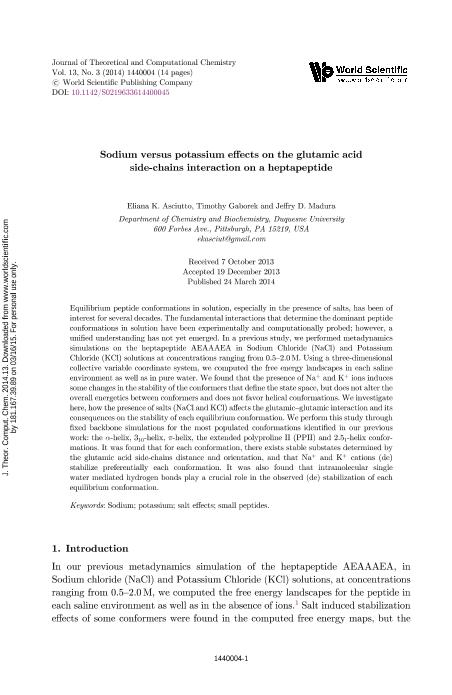Mostrar el registro sencillo del ítem
dc.contributor.author
Asciutto, Eliana Karina

dc.contributor.author
Gaborek, Timothy
dc.contributor.author
Madura, Jeffry D.
dc.date.available
2018-01-22T21:08:54Z
dc.date.issued
2014-05
dc.identifier.citation
Asciutto, Eliana Karina; Gaborek, Timothy; Madura, Jeffry D.; Sodium versus potassium effects on the glutamic acid side-chains interaction on a heptapeptide; World Scientific; Journal of Theoretical and Computational Chemistry; 13; 3; 5-2014; 1440004-1440018
dc.identifier.issn
0219-6336
dc.identifier.uri
http://hdl.handle.net/11336/34193
dc.description.abstract
Equilibrium peptide conformations in solution, especially in the presence of salts, has been of interest for several decades. The fundamental interactions that determine the dominant peptide conformations in solution have been experimentally and computationally probed; however, a uni¯ed understanding has not yet emerged. In a previous study, we performed metadynamics simulations on the heptapeptide AEAAAEA in Sodium Chloride (NaCl) and Potassium Chloride (KCl) solutions at concentrations ranging from 0.5–2.0 M. Using a three-dimensional collective variable coordinate system, we computed the free energy landscapes in each saline environment as well as in pure water. We found that the presence of Naþ and Kþ ions induces some changes in the stability of the conformers that de¯ne the state space, but does not alter the overall energetics between conformers and does not favor helical conformations. We investigate here, how the presence of salts (NaCl and KCl) a®ects the glutamic–glutamic interaction and its consequences on the stability of each equilibrium conformation. We perform this study through ¯xed backbone simulations for the most populated conformations identi¯ed in our previous work: the -helix, 310-helix, -helix, the extended polyproline II (PPII) and 2.51-helix conformations. It was found that for each conformation, there exists stable substates determined by the glutamic acid side-chains distance and orientation, and that Naþ and Kþ cations (de) stabilize preferentially each conformation. It was also found that intramolecular single water mediated hydrogen bonds play a crucial role in the observed (de) stabilization of each equilibrium conformation.
dc.format
application/pdf
dc.language.iso
eng
dc.publisher
World Scientific

dc.rights
info:eu-repo/semantics/openAccess
dc.rights.uri
https://creativecommons.org/licenses/by-nc-sa/2.5/ar/
dc.subject
Ions
dc.subject
Sodium
dc.subject
Potassium
dc.subject
Heptapeptide
dc.subject
Salt Effects
dc.subject
Small Peptides
dc.subject.classification
Astronomía

dc.subject.classification
Ciencias Físicas

dc.subject.classification
CIENCIAS NATURALES Y EXACTAS

dc.title
Sodium versus potassium effects on the glutamic acid side-chains interaction on a heptapeptide
dc.type
info:eu-repo/semantics/article
dc.type
info:ar-repo/semantics/artículo
dc.type
info:eu-repo/semantics/publishedVersion
dc.date.updated
2018-01-16T18:01:16Z
dc.identifier.eissn
1793-6888
dc.journal.volume
13
dc.journal.number
3
dc.journal.pagination
1440004-1440018
dc.journal.pais
Singapur

dc.description.fil
Fil: Asciutto, Eliana Karina. Duquesne University. Department of Chemistry and Biochemistry; Estados Unidos. Consejo Nacional de Investigaciones Científicas y Técnicas; Argentina
dc.description.fil
Fil: Gaborek, Timothy. Duquesne University. Department of Chemistry and Biochemistry; Estados Unidos
dc.description.fil
Fil: Madura, Jeffry D.. Duquesne University. Department of Chemistry and Biochemistry; Estados Unidos
dc.journal.title
Journal of Theoretical and Computational Chemistry

dc.relation.alternativeid
info:eu-repo/semantics/altIdentifier/doi/http://dx.doi.org/10.1142/S0219633614400045
dc.relation.alternativeid
info:eu-repo/semantics/altIdentifier/url/http://www.worldscientific.com/doi/abs/10.1142/S0219633614400045
Archivos asociados
